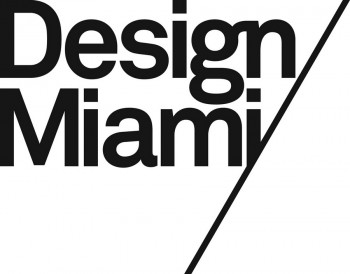Design Miami/ 2014
Tuesday December 2, Preview Day (by invitation only), Press Conference 2:30pm, Collectors Preview 12-6pm, Vernissage 6-8pm
 December 3-7, 2014
December 3-7, 2014
December 3-4, 10am-8pm
December 5, 11am-8pm
December 6, 12-8pm
December 7, 12-6pm
19th Sreet & Meridian Avenue
Miami Beach
Ten years ago, a small fair for collectible design named design.05 Miami launched concurrently with Art Basel Miami Beach. Located in the Moore Building in the Miami Design District, it offered a selection of fifteen invited exhibitors, with the stated aim of bringing museum-quality galleries together with the best collectors, connoisseurs, and designers from around the world in one of the premier destinations for art and design.
Remaining true to that aim, the intervening decade has seen the blossoming and expansion of the fair alongside the market for collectible design, evidenced by the number of participating galleries, which has almost tripled in that period. As it has matured, Design Miami/ has lead the field in establishing new global standards for creative and inspiring exhibitions, turning the fair into an essential destination for the design press and enthusiasts as well as collectors.
Rodman Primack, Executive Director of Design Miami/ stated, “The fair grew out of the need for a consolidated marketplace that would act as a platform to showcase the range and strength of what was then a fledgling market.†Adding, “Since then, the collectible design market has really changed in scale; it’s internationalized and diversified, and this is reflected very clearly in the fair. Design Miami/ has changed the way galleries engage with their audiences. I am excited to see this ecosystem bringing so many distinct viewpoints and aesthetics together.â€
The burgeoning interest in contemporary design from around the US is particularly evident this year, with the invitation of first-time participants Edward Cella Art+Architecture of LA and Gallery Diet of Miami. These two newcomers to the fair are joined by returning participants Volume Gallery, Chicago and Johnson Trading Gallery from New York. Design Miami/ 2014 also welcomes regular participants of the Basel fair, Galleria O., Rome, specializing in Italian twentieth century and international contemporary design, Galerie Pascal Cuisinier from Paris, with their focus on French design from the 1960s and 70s, Carwan Gallery, Beirut, emphasizing work from Western designers interpreting Middle Eastern craft and Nilufar Gallery, Milan, known for Italian postwar design.
The Miami fair and its Basel sibling have maintained strong bonds with the founding galleries that participated in that first design.05 Miami. Eleven founding galleries of the original fifteen – including the previously mentioned Nilufar Gallery, Casati Gallery, Cristina Grajales Gallery, Demisch Danant, Galerie kreo, Galerie Patrick Seguin, Jousse Entreprise, LAFFANOUR-Galerie Downtown, Magen H Gallery, R & Company and Hostler Burrows – will be participating in Design Miami/ 2014.
Zesty Meyers, Principal of R & Company, New York commented, “I think what we’ve accomplished in ten years is amazing. Design Miami/ and Design Miami/ Basel have brought a global audience to us: because of them, I don’t know what languages will be spoken in my gallery today. The power of acting under the Design Miami/ umbrella as a group of galleries attracts buyers that we’d never attract individually – we keep on getting first time buyers. Because of the clients we have through Design Miami/, we can invest in scholarship and research; we can publish major books and hold museum shows. At a certain point, these pieces we are selling from the twentieth century will be gone – we’re saving history with these works, and creating future history with the contemporary.â€
Equally excited by the future as it is inspired by the past, Design Miami/ is launching two new forward-looking initiatives this year: the exhibition strand Design Curio, and the Design Visionary award.
Conceived as contemporary cabinets of curiosity, the four independently curated Design Curio booths scattered throughout the fair will take the widest possible view of design practice. They will go beyond the scope of collectible design to embrace diverse fields from science and technology, to handcraft, and from unrealized prototypes to esoteric collections.
Design Visionary
The new Design Visionary award from Design Miami/ celebrates individuals who have significantly contributed to the field of design, such as collectors, curators, architects and luminaries who influence and are engaged in design in the broadest sense. The laureate of the Design Visionary award is recognized as having a continued, tangible and lasting impact.
The inaugural Design Visionary award will be presented to Peter Marino in December 2014. With this award, Design Miami/ recognizes Marino for his achievements as an architect, for his knowledge and status as a collector of design, art and the decorative arts, and for the impact he has had as an advisor on contemporary and twentieth century design to his numerous clients.
Commenting on the first edition of this award, Primack stated, “This award is about recognizing the figures that have really propelled the world of design in the broader sense. Peter is a great talent, and is also an amazing patron of others’ talents. His knowledge of furniture, his ability to create collections in design and his work with leading brands to help them understand the importance of bringing design voices into their world have substantially impacted the market and the language of designâ€.
Marino founded his eponymous architecture, planning and design studio in New York in 1978 having trained with I. M. Pei and George Nelson. Early clients included Andy Warhol, Yves Saint Laurent and Pierre Bergé, and Gianni and Marella Agnelli.
Alongside his work with private clients, Marino has redefined luxury in the retail space, creating store environments around the world for houses such as Chanel, Dior, Louis Vuitton, Bulgari, Graff and Ermenegildo Zegna, commissioning site specific works of art for many of them. His numerous collections include contemporary art and design, photographs, porcelain, and Renaissance and Baroque bronzes, the latter of which were shown at London’s Wallace Collection in 2010 in the exhibition Beauty and Power: Renaissance and Baroque Bronzes from the Peter Marino Collection. In 2012 he was named a Chevalier de l’Ordre des Arts et des Lettres by the French Ministry of Culture.
At Design Miami/ 2014, Marino will be the subject of an exhibition celebrating his multiple roles within the world of design. In a stand-alone display space designed by the architect, the exhibition will feature antique and contemporary chairs from his collection, architectural maquettes and images, and his series of cast bronze boxes.
Pavilion Commission
Minneapolis-based designer Jonathan Muecke has been commissioned to create the Pavilion for the tenth anniversary of Design Miami/.
The Design Miami/ Pavilion Commission has become an important feature of the fair. An ephemeral extension of the fair space itself, the pavilion is at once an exhibit and a piece of functional temporary architecture. While the commission is traditionally given to an early career architect or studio, for its tenth anniversary Design Miami/ has selected a designer whose practice reflects the multifaceted nature of the fair itself.
Alexandra Cunningham Cameron, Creative Director at Design Miami/ commented, “For our tenth anniversary, we wanted to pay homage to the type of young designer that Design Miami/ wishes to champion – one who experiments with materials, form and scale; who is as much a theorist as a maker; and who challenges us to consider how we relate to the world built around us.â€
Jonathan Muecke studied architecture at Iowa State, interning at the architectural office of Herzog & de Meuron in Basel, Switzerland before studying design at the Cranbrook Academy of Art. Muecke has evolved a design practice that resists standard divisions between design, art and architecture, instead focusing on refined forms that investigate notions of positive and negative space, positional relationships to structures and the innate desire to read notions of functionality into objects that relate to human scale.
Centered around a double-layered circular structure with apertures at both poles, Jonathan Muecke’s Design Miami Pavilion (DMP) is designed on a human scale, rejecting monumentality in favor of lightness and variability. Filtered through a translucent canopy that shelters the whole structure, light will bounce off the curved and colored surfaces of the pavilion – complementary tones of red and green within, primary blue and yellow without – creating a shifting topography of reflected color. Seamlessly shaped seating units made from composite will allow visitors a moment of quiet reflection in a space conceived in part as a refuge from the hyper-stimulating environment of the fair itself.

